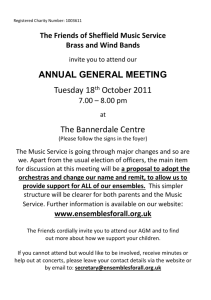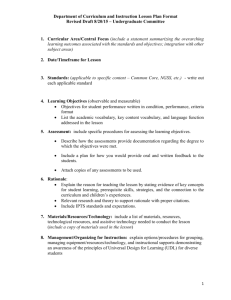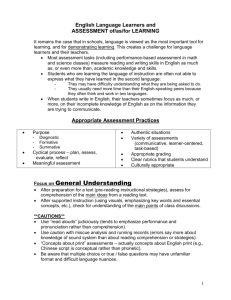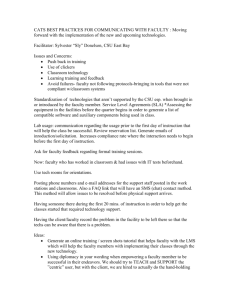Study Guide
advertisement
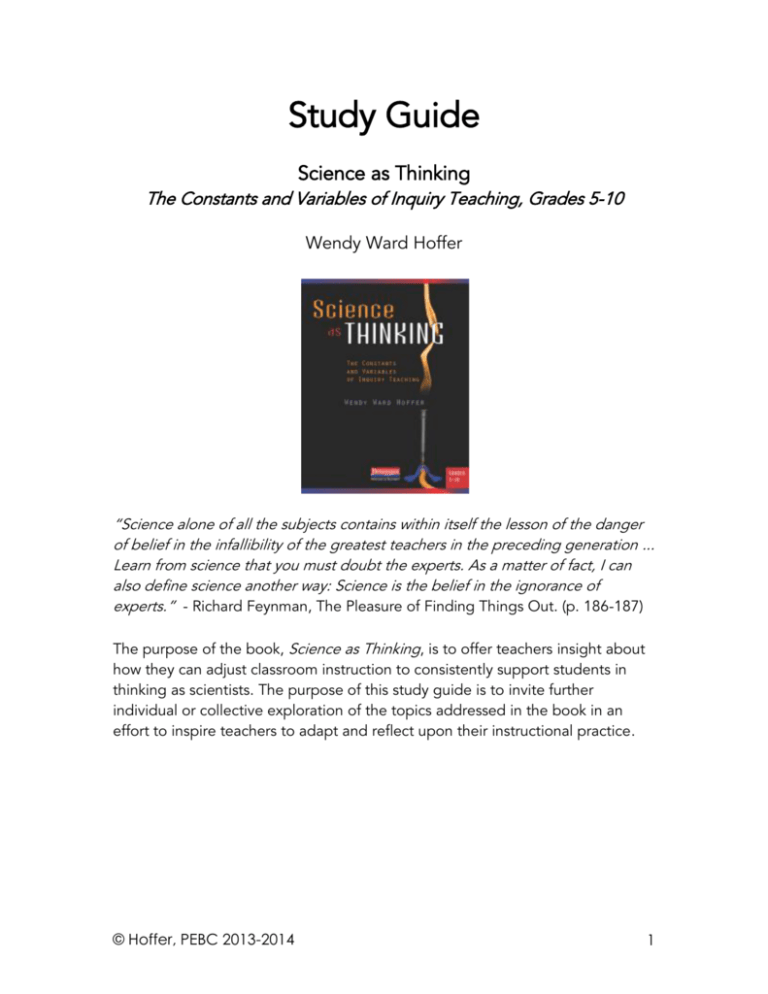
Study Guide Science as Thinking The Constants and Variables of Inquiry Teaching, Grades 5-10 Wendy Ward Hoffer “Science alone of all the subjects contains within itself the lesson of the danger of belief in the infallibility of the greatest teachers in the preceding generation ... Learn from science that you must doubt the experts. As a matter of fact, I can also define science another way: Science is the belief in the ignorance of experts.” - Richard Feynman, The Pleasure of Finding Things Out. (p. 186-187) The purpose of the book, Science as Thinking, is to offer teachers insight about how they can adjust classroom instruction to consistently support students in thinking as scientists. The purpose of this study guide is to invite further individual or collective exploration of the topics addressed in the book in an effort to inspire teachers to adapt and reflect upon their instructional practice. © Hoffer, PEBC 2013-2014 1 Before Reading Discussion Questions: • How do you feel about yourself as a scientist? • What are your beliefs about how students develop their scientific thinking abilities? • How are you integrating Next Generation Science Standards (NGSS) Practices for Science and Engineering into your daily lessons? (These are available as Appendix F at http://www.nextgenscience.org/nextgeneration-science-standards) • How do you track learners’ understanding? • What are your aspirations as a science teacher? • What are the constants in your science instruction? The variables? • What are you curious about as a scientist? • As you read on, what are you hoping to learn more about? Activities: • Reflect on your own experiences as a science learner: What do you remember most? Why? When did you feel most like a thinker and problem solver? • Brainstorm all of the ways in which you invite learners to think as scientists in the context of your class(es). • Read science current events. Select one recent discovery or invention, and take time to consider what sorts of activities the scientists or inventors engaged in in order to arrive at that outcome. • Invite a colleague to observe you and your students during a typical science lesson and to notice when and how students engage in thinking as scientists. During Reading Chapter 1: Inquiry Discussion Questions • What is inquiry? • How are you already engaging students in inquiry within the context of their science learning? • What is the relationship between content learning and the development of scientific thinking? • What are some of the challenges associated with facilitating inquiry, and how might you address those? © Hoffer, PEBC 2013-2014 2 • What is the relationship between the National Research Council’s description of inquiry and the NGSS Science and Engineering Practices (Appendix F)? Activities • Revise an upcoming activity with an eye on integrating more inquiry. • Observe a colleague striving to implement inquiry; record her class in action, and debrief the observation: What worked? What did you learn? What will you try next? •Examine a recent activity using the table on page 12. What do you notice? •Using the graphic organizer on page 24, reflect on your instruction as a whole: what are you already doing to promote inquiry, and what might you add? Chapter 2: Big Ideas Discussion Questions • What are Big Ideas, and why are they important? • Which Big Ideas appeal to and make most sense to you? • What role could Big Ideas play in your classroom? At your grade level? In your school? • In what ways could you support students in connecting a typical unit to a Big Idea? • How do the Big Ideas presented in this book compare with the Crosscutting Concepts proposed by the NGSS in Appendix G? Activities • Plan a unit through the lens of a particular Big Idea. Notice how this affects what you choose to emphasize and leave out. • Introduce learners to the notion of Big Ideas. Offer them time to brainstorm specific examples of each. • Using the graphic organizer on page 36, plot your curriculum units by science strand and Big Idea for this school year. For those units that could connect with more than one Big Idea, select the one that makes the most sense to you. • Repeat the task above with your grade level science department colleagues, and explore how you can balance emphases on a variety of content strands and Big Ideas throughout a child’s learning experiences at your school. Chapter 3: Workshop Discussion Questions • What rituals and routines have you established for learning time in your classes? © Hoffer, PEBC 2013-2014 3 • What is your experience, if any, with implementing workshop model in any content area? How is science workshop unique? • How do you release to students the responsibility for doing the majority of the thinking, working and talking in your classes? • What are some of the difficulties associated with implementing science workshop, and how might you address those? • Look at the list of Exit Ticket ideas on page 50. Discuss and decide which of these or your own you might use to invite learners to synthesize and share their thinking at the close of a workshop. Activities • For each lesson, task and unit, plan for the kind of thinking you want to apprentice students to do and how you will facilitate their success with targeted mini-lessons. • Observe a peer implementing workshop model in science or another content area. Document what you see and hear from teacher and students during each segment of the workshop. • Use the planning questions on page 52 to design a series of workshop model lessons. Chapter 4: Assessment Discussion Questions • Analyze the graphic on page 61. In what ways does this reflect or differ from how you already plan instruction? • How do you determine process and content learning targets for each task? • How do you know what students understand? • How do you see the relationship between formative and summative assessment? • What is your experience with conferring. • Why are additive rubrics helpful to learners? Activities • Make an intentional plan to confer with a given number of students each week, and track those conversations. • Gather and analyze the rubrics you and your school use. Compare them to the additive rubrics presented in this book (pages 72, 113, 129, 163, 205). What do you notice? • Design and use an additive rubric for an upcoming activity. © Hoffer, PEBC 2013-2014 4 Chapter 5: Culture Discussion Questions • Describe the best learning community you have experienced. • What are your beliefs about the culture that supports students’ learning? How do you intentionally structure your classroom and students’ experiences in it to reflect those beliefs? • How do you make decisions about group size? Discuss the table “Matching Group Size to the Task” at the top of page 87. • What challenges do you face in establishing positive peer culture, and how might you effectively address those? Activities • Use the planning questions at the bottom of page 74 to reflect on and plan for intentional culture in your classroom. • Develop and distribute a survey among your students to learn how they feel about the learning community in your classroom. Tabulate and share the results; discuss how you all might strengthen the community even more. • List common transgressions in your classroom and the consequences you frequently dole out. Consider how these consequences support the development of classroom community. • Devote time each day to document, offer feedback and invite learners to reflect on their culture-building behavior. What do you notice? Variables Discussion Questions • Which of these do you most often use in your instruction and why? Activities • Survey students about which of the instructional methods included in the variable section they a) enjoy most, and b) feel they learn most from. • Study one past unit of instruction. Tally how often you used each of the instructional methods included in the variables section. What do you notice? Chapter 6: Labs Discussion Questions • What role did labs play in your own science learning? • How would you define a “lab”? © Hoffer, PEBC 2013-2014 5 • Compare the “Science Process Skills and Examples” on page 103 to the NGSS Science and Engineering Practices (NGSS Appendix F). • How do labs A, B and C compare with the labs you and your students have been using? • When you examine labs A, B and C on pages 105 - 107, what place do you see for each format in your science instruction? • How do you support students in growing their capacity to conduct labs more independently? Activities • Observe another teacher facilitating a lab. Notice how she invites student thinking and addresses the NGSS Science and Engineering Practices. • Using the planning questions on page 114, plan for an upcoming lab. • Examining your curriculum across the year, plan for which aspects of lab work you will gradually release to students, within which unit, and how. • Explore your school’s science storage closet. Notice the materials and equipment are available to you that you may not have used in the past. What does this inspire you to try? Chapter 7: Demonstrations Discussion Questions • What role did demonstrations play in your own science learning? • When do you chose to instruct by using a demonstration? • What are the disadvantages of demonstrations? • Brainstorm a variety of ways for students to hold their thinking while observing demonstrations. Activities • Attend a peer presenting a demonstration lesson and observe student engagement. • Use the questions on page 129, plan an upcoming demonstration. • Teach a student to present a demonstration to your class. • Create a rubric for demonstrations. Invite your students to assess your and peers’ demonstrations with this tool. • Create a Venn diagram comparing the learning opportunities in labs vs. demonstrations. © Hoffer, PEBC 2013-2014 6 Chapter 8: Lectures Discussion Questions • What role did lecture play in your own science education? • When do you believe that lecture the best mode of delivering content? • What is the value of graphic organizers or note-catchers for students, and when do they impede students’ learning? • Brainstorm connections to the topics in the table on page 140, as well as to some of your own. Activities • Attend a lecture. What do you notice about yourself as a learner during this lecture? • Examine an upcoming unit, and consider when and why you will use lecturebased instruction. • Using the planning questions on page 144, design a lecture-based lesson. Invite a colleague to observe and offer feedback on your presentation. • If you teach the same content to more than one group, conduct an experiment: create a graphic organizer for an upcoming lecture. Offer it to one group but not the other. Assess which group remembered more from the learning experience. Chapter 9: Discussion Discussion Questions • When is a discussion a useful opportunity for students learning? • How do you ensure that discussions stay focused on learning goals? • How do you equalize opportunities for students to share their thinking within a discussion? • What have you found useful to motivate and engage reluctant participants in a discussion? • How do you assess students’ understanding gleaned from a discussion? Activities • With your class, analyze the sample discussion rubric on page 167 and revise it together. Hold a discussion and invite learners to use this rubric to assess themselves. • Select a discussion structure from the list on pages 159 – 160. Practice facilitating a discussion about a topic of shared interest in this format with your peer study group. © Hoffer, PEBC 2013-2014 7 • Look over your plans for the year. For each unit, consider what connections can be made to current events or ethical issues and how you could design a discussion for each. Chapter 10: Reading Discussion Questions • When and how do you ask students to read as scientists? • How do you teach reading? Do you feel you should? • Examine the CCSS English Language Art Standards for Reading in Science and Technical subjects for your grade level (available online at http://www.corestandards.org/the-standards) and determine which you will focus on addressing and why. • How can thinking strategy instruction support students’ content learning? • How will their ability to read science content impact students’ future opportunitites? Activities • Where do you find high quality reading material for your students? Compile a resource list or create a website with links to share among colleagues. • For an upcoming unit, develop a text set that includes images, graphs, charts, articles and other texts that students can read. Plan to integrate those within their learning experiences. • Using the sample unit on pages 186-187 and the planning questions on page 188, develop an upcoming unit with an explicit focus on a thinking strategy and intentional instruction of reading non-fiction texts. Chapter 11: Projects Discussion Questions • What is the role of projects in your instruction? • How might you use projects to scaffold understanding? • What are some of the challenges associated with facilitating projects, and how might you address those? • Annotate the list of project ideas types on page 200 as follows: put a check next to the sorts of activities you already do. Underline those you would you like to try. Cross out those that do not appeal. Add new ideas to the list. Discuss your selections and next steps. • How can workshop model instruction support students’ learning within long term projects? © Hoffer, PEBC 2013-2014 8 Activities • Complete the chart on the bottom of page 203. Add new rows for ideas of typical projects you could transform. • Develop a project using the planning questions on page 206. Devise a series of mini-lessons to launch the project. • Complete an upcoming project yourself to create a parallel model for students. • Review and revise the rubric on page 205 to be a useful assessment tool for an upcoming project. Chapter 12: Activities Discussion Questions • How does Bloom’s Taxonomy connect with Norman Webb’s work on cognitive demand? • What are your go-to learning activities? • What strategies do you use to promote thinking amidst learning activities? • How can you use video clips and other media to promote thinking and enhance understanding? • If you use science kits, how do you select and utilize the activities they contain? • Annotate the list of activity types on page 218 as follows: put a check next to the sorts of activities you already do. Underline those you would you like to try. Cross out those that do not appeal. Discuss your selections and next steps. Activities • Post Bloom’s Taxonomy or Webb’s Levels of Cognitive Demand in your classroom or office to remind you of how to increase challenge for learners. • Using the chart at the top of page 219, classify the activities from your most recent science unit(s). What do you notice? • Using the planning questions on page 227, plan an upcoming activity. Invite a colleague to come and observe you teach this lesson and offer feedback. Chapter 13: Fieldwork Discussion Questions • Why are field trips worth the effort? • Describe your best field trip ever, either as a teacher or a student. What made it successful? • Describe your worst field trip and why it failed. © Hoffer, PEBC 2013-2014 9 • Brainstorm and discuss solutions to common field trip challenges. • What can teachers do before, during and after field trips to maximize student learning? Activities • Write a chaperone’s guide to successfully facilitating student learning on a field trip. • Brainstorm field trip ideas for each upcoming unit. • Use the checklist on page 241 to plan a field trip. • Plan before, during and after activities for the trip you just planned. After Reading Discussion Questions • How can the ideas in this book support you in addressing the Next Generation Science Standards? • What elements of Science as Thinking do you aspire to integrate into your instruction? How? What support will be helpful to you as you move forward? • What are you still curious to understand about science instruction? Activities • Set goals for adjusting your instructional practice; invite a colleague to hold you accountable for following through. • As a study group, compile your comments and questions, and send those to the author, Wendy Ward Hoffer <whoffer@pebc.org> She will write back! © Hoffer, PEBC 2013-2014 10


